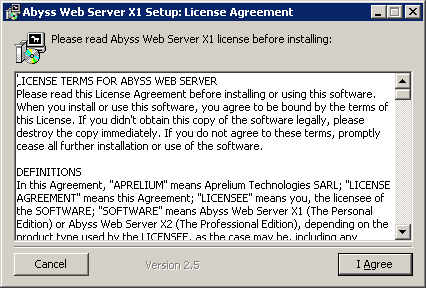
- #ABYSS WEB SERVER NO SHTML FILE HOW TO#
- #ABYSS WEB SERVER NO SHTML FILE UPDATE#
- #ABYSS WEB SERVER NO SHTML FILE FREE#
You can use this to run the server on another machine and redistribute the processor load. Extensions Step 1: Setting Up the InterpreterįastCGI (Remote - TCP/IP sockets) - Abyss will look for the Mono server at a specified IP address and port. If you decide to use this configuration, please bear in mind that it is less secure suffers additional disadvantages when compared to using paths. Please consult FastCGI#Paths_vs._Extensions on the main page for an in depth explanation. Using Extensions in place place of paths is NOT recommended. If directory listing is enabled, paths aren’t automatically sent to the FastCGI Mono Server. Once there, click “Directory Listing” and proceed to set “Type” to “Disabled”. Click “OK” at the bottom of the page to get back to the host configuration page. Upon completion of the previous step, you should have automatically returned to “Scripting Parameters”. General Step 3: Disabling Directory Listing Once you’ve chosen your value, click “OK”. 604800 is the number of seconds in a week and the value I chose for my server. Because ASP.NET pages need to recompiled and AppDomains need to be recreated every time the server starts up, you want to set this value to some arbitrarily high value. The option “FastCGI Processes Timeout” specifies the number of seconds after the last request you’re going to want to wait before shutting down the Mono (or any) FastCGI server. Click on “Edit…” next to “FastCGI Parameters”. General Step 2: Extending the Server Lifetime Click on “Add” in the “Script Paths” box.
#ABYSS WEB SERVER NO SHTML FILE UPDATE#
Uncheck “Use the associated extensions to automatically update the Script Paths”.This option improves performance but can disturb ASP.NET 2.0 as it sometimes uses paths that don’t necessarily exist like WebResource.axd. Uncheck “Check for file existence before execution”.For the command line shown above, this would be 8002. If using this option, simply set “Remote server IP Address” to the IP address of the machine running the Mono server, and “Port” to the port you used in the command line. The only caveat is that you will need to start the Mono server on the other computer manually, using a command like fastcgi-mono-server2 /socket=tcp:8002. If using this option, simply set “Interpreter” to “/usr/bin/fastcgi-mono-server” or “/usr/bin/fastcgi-mono-server2”.įastCGI (Remote - TCP/IP sockets) - Abyss will look for the Mono server at a specified IP address and port. Pipes are the fastest way to communicate and having the Abyss spawn its own server means you don’t have to do it manually.

The two options I would recommend are “FastCGI (Local - Pipes)” and “FastCGI (Remote - TCP/IP sockets)”:įastCGI (Local - Pipes) - Abyss will start the Mono server by itself using a piped socket. You are now on the page to add the ASP.NET interpretter.Click on “Add” in the “Interpreters” box.Click “Configure” on the host you wish to add ASP.NET support to.Upon starting the Abyss Web Server, a control center web server starts up as well, by default at Simply open it up in your web browser to that address and follow the steps outlined below: General Step 1: Setting Up the Interpreter


#ABYSS WEB SERVER NO SHTML FILE FREE#
Although closed source, the X1 server is “a free and fully functional software: no nag screens, no time limitations, no spyware, and no advertisements.” ( Download) IntroductionĪbyss Web Server is a easy to use and feature rich Web Server.
#ABYSS WEB SERVER NO SHTML FILE HOW TO#
Information on how to configure the FastCGI support for the Abyss server.


 0 kommentar(er)
0 kommentar(er)
